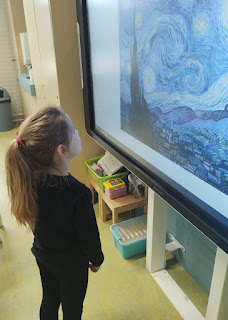by a student of grade 6
You need:
- for prints: black and white sheets 18 by 14 cm
- for background: black and white construction paper 31 by 19 cm
- linoleum 16 by 12 cm
- carbon paper
- lino knife
- flat piece of glass
- block printing ink
- lino roller
- lino press
- glue
The painting The bedroom is from 1888. View this painting and discuss it using elements of art. What do you see? What stands out? What do you see on the wall? What can you say about the perspective? What materials did Van Gogh use? What do you think about the colors? Do you like the painting or not, and why is that?
Cut out your name in mirror writing at the bottom left.
Make four prints: two with white paint on black paper and two with black paint on white paper. Let dry.
Stick the white sheets on black paper and the black sheets on white paper. Use 1 cm of the sheets to stick them together.
all artworks of grade 6
Elements of art: color, space, line.



















